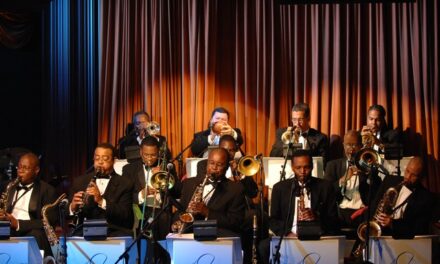Mallarmé Chamber Players presented “Wonder Women,” a concert featuring music from artistic giants of our time: Sofia Gubaidulina (b.1931); Libby Larsen (b.1950); Thea Musgrave (b.1928); Joan Tower (b.1938); and Gwyneth Walker (b.1947). The program was a collaborative effort with the Nasher Museum of Art on the campus of Duke University. The title is taken from a multi-media work by Dara Birnbaum, “Technology/Transformation: Wonder Woman” (1978-79), on exhibit as part of The Deconstructive Impulse: Women Artists Reconfigure The Signs Of Power, 1973-1991.
Libby Larsen is one of the most important and successful contemporary composers as well as a fierce advocate for the arts. Her list of commissions and awards, including a Lifetime Achievement Award from the American Academy of Arts and Letters, speaks for itself. She was a co-founder of the Minnesota Composers Forum, now the celebrated American Composer’s Forum, which has been an important means for up-and-coming composers to have audiences hear their works. It was exciting to hear two of her compositions on this program.
The concert was opened by Tim Hudson, trumpeter and director of the Carolina Brass, with Libby Larsen’s glorious “Fanfare for the Women” (1994), a two-minute piece premiered by Lynn Erickson at the University of Minnesota’s Women’s Sports Pavilion. It is the kind of piece that sets the hair on your arms on end. It was written for a large, open space, but the sound fell short in the Nasher Auditorium, which is acoustically dead. Nevertheless, Hudson gave it his all, and he has more than ample chops for the piece.
Larsen’s Up, Where the Air Gets Thin (1984) was performed on the second half by John Brown (bass) and Bonnie Thron (cello). For most of us, this was a delightful chance to hear players from the “bottom” of the symphony shine. It’s a beguiling duet that “explores imaginatively strange acoustic effects at extreme heights” (Larsen’s notes). I loved hearing the edgy, close-to-the-bridge work ricochet with the bow and harmonics performed in a truly musical setting. Once again however, the acoustics worked against them, so instead of the intended harmonic overlap being clear, the sound died away too quickly. But the piece worked satisfactorily — and it was compelling and beautifully executed.
When Joan Tower played piano with her chamber music ensemble, Da Capo, she frequently wrote works for them to perform. But it was during a residency (1985-88) with Leonard Slatkin and the St. Louis Symphony that she gained confidence as a composer. “Island Prelude” (1988) was written for Peter Bowman and originally scored for solo oboe and string orchestra. The quartet version heard in Durham was very effective. In fact, the piece sounds less like a concerto in this edition — and genuinely natural — but it is true that the dynamic and textural contrasts that make the orchestral version so dramatic are minimized. In her notes Tower writes of “… a large, powerful and brightly colored bird which soars and glides, spirals up, and plummets with folded wings as it dominates but lives in complete harmony with its island home.” Bo Newsome’s gorgeous cadenza playing was meticulous and rich — if only birds could sing that well.
Jacqueline Wolborsky (violin) performed Tower’s 1977 “Platinum Spirals.” It calls for technical virtuosity, she nailed it, but she also made sense of a piece that can easily put an audience at arm’s length. Her phrasing gave it musical sense and warmth without disturbing the intent of the composer. And yes, the shoes were perfect.
There followed the world premiere ofGwyneth Walker’s Language of the Soul for trumpet and string quintet , commissioned and performed by Tim Hudson (trumpet), an instructor at Gardner Webb University. Dr. Walker, Composer-in-Residence for the week, introduced herself and explained that the work is “… an expression” of her personality, a free spirit who delights in her life on a dairy farm in Vermont. In her notes she writes, “… this four-movement work … aims to explore several of the ‘messages‘ which the soul might choose to speak: peace, wonder, freedom and joy.” Her music is rich in harmonic texture (very tonal), upbeat, and accessible to any audience. The quintet most obviously enjoyed the piece, and Hudson played with the requisite sparkle. As MCP Artistic Director Suzanne Rousso said in conversation, “… it sounds truly American.” Surely it will take its place in the repertory.
Also on the program was Sofia Gubaidulina’s exquisite String Quartet No. 2 (1987), a piece that fits side-by-side with Penderecki’s early work. The Mallarmé Quartet’s ensemble playing was exceptional — I hope they will play more.
Newsome returned for Thea Musgrave’s “Niobe” for oboe and tape. It is the only “electronic” piece she has composed, as far as I know. The oboist’s scintillating performance reminded me that I live in a rich musical environment (central North Carolina); how fortunate we are to enjoy such artistic bounties!
The concert was sponsored by Mark and Cindy Kuhn. Dr. Walker’s residency activities were funded by a grant from Meet the Composer’s MetLife Creative Connections program. The residency included visits to the Durham School of the Arts and the North Carolina School of Science and Mathematics.











